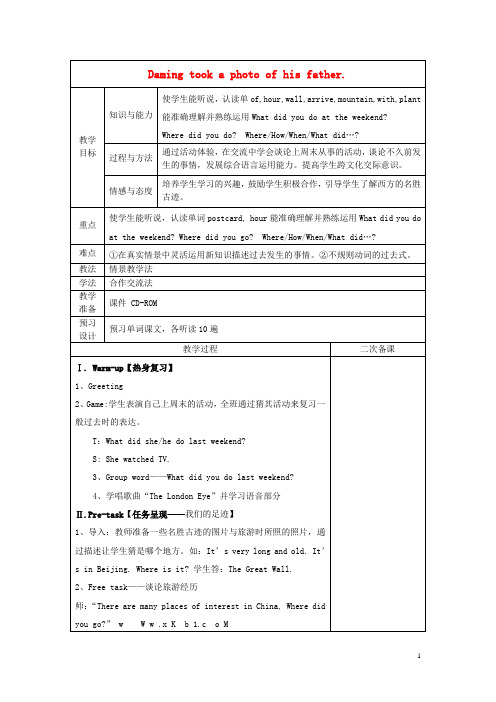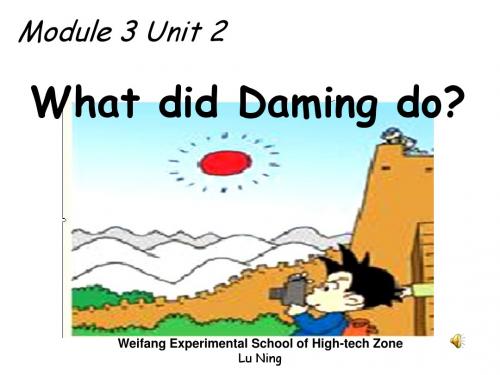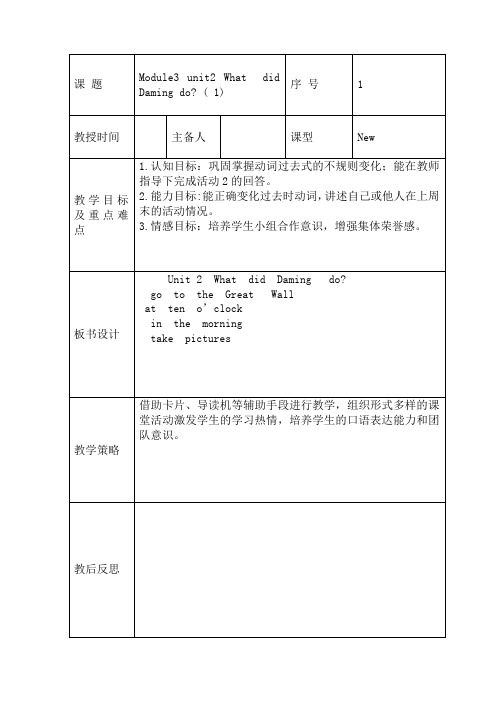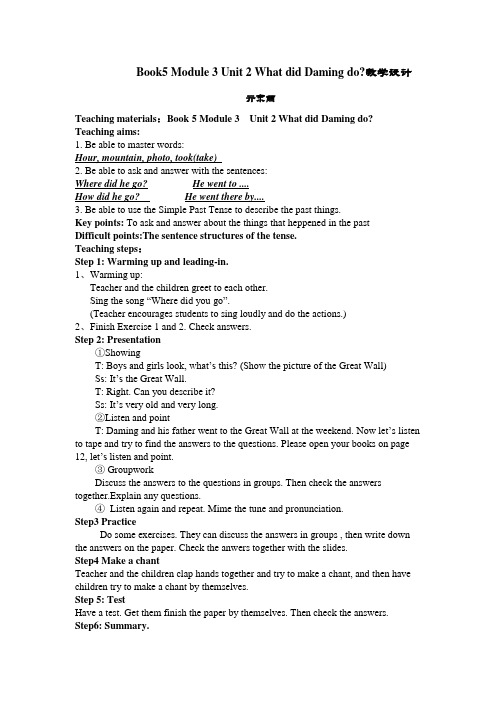What did Daming do 教案
- 格式:doc
- 大小:58.00 KB
- 文档页数:5



Unit 2 Daming took a photo of his father.教学目标一、知识目标1.认读单词:of,wall,arrive,for,mountain,with,plant2.运用句型:sb.did sth.二、技能目标能口头运用“Where/When/How did sb....?What did sb. do?”“Sb.did...”这类语句来描述过去所发生事情的具体信息。
三、情感目标培养学生学习的兴趣,鼓励学生积极与他人合作,感受长城的壮观,热爱中国山河之美。
四、学习策略通过问题的展示,引导和启发学生在各种情境中感受语言的交际功能,在阅读教学活动中,逐步掌握阅读技巧。
五、文化意识进一步了解中西方国家的重要标志物,强化爱国意识。
教学重点掌握本单元重点单词教学难点学生能够透彻理解Where/When/How did you...?这类语句询问过去发生事情并能作出回答,在老师的帮助下灵活运用。
课前准备多媒体课件,长城道具,单词书写卡教学过程Step1Warm up1.Greeting.2.Brain storm.【设计意图】通过头脑风暴游戏,既复习了已学的部分疑问词,起到了热身作用,又使学生的注意力集中到课堂教学中来,可谓一举两得。
《爸爸去哪儿》节目的相关图片能够引起学生的极大兴趣,使学生积极地参与到课堂活动中来。
Step2Lead inGuessing:What did Daming do?【设计意图】此环节设置了一个悬念,让学生带着疑问进入文本,并在文本中获取有效信息,培养学生解决问题的能力。
Step3Presentation1.Listening:(Task 1:Listen and find:What did Daming see?)①check the answers:the great wall/mountain(s)/plant(s)/flowers②learn words:of,wall,arrive,for,mountain,with,plant2.Listening:(Task 2:Listen and circle out the answers.)①show the questions:Question 1:Who went to the Great Wall?Question 2:Where did they go?Question 3:How did they go there?Question 4:When did they arrive?Question 5:What did Daming do?②figure out the answers③summarize:4w+1h(what,when,who,where and how)3.Listening:(Task 3:Complete the contents by using the writing on the blackboard.)①retell the contents【设计意图】本课重难点皆在培养学生的初步阅读能力,通过层层递进、由易到难、不断突破,并围绕语篇教学,让学生能利用阅读小技巧初步形成阅读能力,进行有效阅读。


Module8 Unit2 I took some pictures.教学内容分析本模块的教学内容是谈论和评价过去的行为。
本单元的课文情境是Daming向妈妈介绍这次野餐的情形。
他告诉妈妈这次野餐玩得很开心:他们做了游戏,吃了很多好吃的东西,喝了果汁和牛奶,他还拍了很多照片,制作了一张海报。
妈妈表扬了Daming。
教学目标1、全体学生能认读took,tell,great,made并运用;全体学生能理解took,tell,great,delicious,made,poster,部分学生能运用delicious,poster2、全体学生能听懂、会说I took some pictures.3、全体学生能够运用一般过去时谈论和评价过去的行为。
4、全体学生能够积极运用所学英语进行表达和交流,乐于感知并积极尝试使用英语。
教学重难点不规则动词的过去式教学过程Lead in1、Greeting2、Warming up(1)Brain stormingRead the words or the phrases quickly and loudly.(2)Let’s sing a song <What did you do?> and do the actions.(设计意图:快速复习动词过去式及动词过去式短语,复习句型What did you do?及回答。
)3、Lead inI took some pictures last weekend.What did you do last weekend?Look at Daming ,can you guess what did Daming do?Today we’ll learn Module8 Unit2 I took some pictures.4、Watch a video<Peppa pig’s picnic>5、GroupDo you want to have a picnic? Today we have two groups. We’ll get lots of delicious food for our picnic. Let’s PK. Ready?(设计意图:观看小猪佩奇的视频,引入Picnic主题,带入情境并分组加入竞争机制)Presentation1、Last Sunday,Daming had a picnic too.Let’s have a look.(1)Watch and answer.What did Daming do on picnic?( D )A.He played games.B.He ate lots of delicious food.C.He took some pictures.D.A BC(2)NewBoys and girls ask Daming,listen to the voice.Read the sentence after the voice .Then study the new words.(3)Listen and repeat,then circle the past tense of verb.(4)Role playIt’s role play time,I’ll give you one minute.Work in pair,clear?(5)Fill in the blanks.Mum:Tell me about your picnic.Daming: It was .We games.We lots of delicious food.I some pictures and I a poster.Mum:That’s great!(6)The simple past tense(微课)(设计意图:学习单词和课文,词不离句,再通过多种角色扮演、填空、复述课文等多种练习,更好的掌握课文。

Book5 Module 3 Unit 2 What did Daming do?教学设计亓宗丽Teaching materials:Book 5 Module 3 Unit 2 What did Daming do? Teaching aims:1. Be able to master words:Hour, mountain, photo, took(take)2. Be able to ask and answer with the sentences:Where did he go?He went to ....How did he go? He went there by....3. Be able to use the Simple Past Tense to describe the past things.Key points: To ask and answer about the things that heppened in the pastDifficult points:The sentence structures of the tense.Teaching steps:Step 1: Warming up and leading-in.1、Warming up:Teacher and the children greet to each other.Sing the song “Where did you go”.(Teacher encourages students to sing loudly and do the actions.)2、Finish Exercise 1 and 2. Check answers.Step 2: Presentation①ShowingT: Boys and girls look, what’s this? (Show the picture of the Great Wall)Ss: It’s the Great Wall.T: Right. Can you describe it?Ss: It’s very old and very long.②Listen and pointT: Daming and his father went to the Great Wall at the weekend. Now let’s listen to tape and try to find the answers to the questions. Please open your books on page 12, let’s listen and point.③ GroupworkDiscuss the answers to the questions in groups. Then check the answers together.Explain any questions.④Listen again and repeat. Mime the tune and pronunciation.Step3 PracticeDo some exercises. They can discuss the answers in groups , then write down the answers on the paper. Check the anwers together with the slides.Step4Make a chantTeacher and the children clap hands together and try to make a chant, and then have children try to make a chant by themselves.Step 5: TestHave a test. Get them finish the paper by themselves. Then check the answers.Step6: Summary.T: I think you did a very good job, so you are wonderful. Today we went to the Great Wall with Daming and his father. Now it’s time for your homework.Step 7: Homework1.Listen to the tape and repeat the text 3 times.2.Finish the Activity Book.3. Draw a knowledge tree of this unit.( Choose)。
M1 u1 课题 Did you come back yesterday? 课型新授教学目标知识与能力 1. 使学生能听、说、认、读when, back, home, those, ice cream, with, finish, hurry, hurry up, wait, drop等单词。
2. 感知句子When did you come back? We came back …,并理解其意思。
3. Talk about our holiday. Using the words 〝Where did you come back?〞过程与方法合作学习,小组学习,交往式学习情感与态度 1.激发学生学习英语的兴趣,使学生树立学习英语的自信心。
2.培养学生的合作交流能力重点 Talk about the past things.难点使用动词过去式,描述过去发生的事情。
教法 1. Listening to the tape. 2. Group work. 3. Using PPT. 4. Using cards.学法 1. Listening to the tape. 2. Work in groups.3. Learning through the PPT.4. Learning words with the cards 教学准备 PPT, computer, tape-recorder, tape, cards 预习设计 1. Talk about your summer holiday. 2. Collect the pictures about your holiday. 教学过程二次备课Step1: Warm up and lead in. 1. GreetingT: Hello, boys and girls. How are you? Ss: I’m fine. Thank you!T: Were you happy in your holiday? Ss: Yes.T: let’s talk about our summer holiday, OK? Ss:OK. (请同学们谈谈自己的暑假生活) 2. lead inT: Where did you go?Ss: I went to... (复习go的过去式went.) T: What did you buy?Ss: I bought…. (复习buy的过去式bought.) T: When did you come back? Ss: …3. Summary the past tense.go--went do--did come--came buy--bought Step2: New words.1. Show words cards and teach the Ss the new wordsMake some screen to learn the words :drop—dropped (如:通过动作.I dropped my pen/book…) wait—waited finish—finished2. Play a game:用单词卡只露第一个字母.让学生猜单词(设计目的:练习单词的认识及拼写能力.)Step3: TextT: Do you know Amy and Sam? Ss: YesT: Where did they go?When did they come back?Listen carefully and answer the questions.T play the tape recorder, Ss listen and answer the questions. Play again, read after the tape. Do the exercises. Choose T or F.( ) 1. Lingling is in London with Sam and Amy. ( ) 2. They are back yesterday. ( ) 3. T hey came back yesterday. ( ) 4. john lives near Amy and Sam. Check the answer. Work in groups. Try to act the text out. Ask some group act in class. Step4: SurveyAsk you Ss and fill in the form Where did you go? What did you by?When did you come back? Step5: Summery Step6: HomeworkDo the form after class. When did you … ?Name Leave Come back【板书设计】 unit1 Did you come back yesterday? go—went Did you come back yesterday? buy—bought We came back last Sunday. do—did finish—finished come—came wait—waited drop—droppedModule 1 Unit 2 We bought ice creams.教学目标 1、语言知识 ---Did you …? ---Yes,I did./No,I didn’t. 2、语言技能能运用Did you …?句型询问对方是否做过某事,对方根据具体情况作出应答 Yes,I did./No,I didn’t.培养学生在具体情景中正确运用该语言的交际能力。
Module3 Unit2教案【内容来源】外研版三起点(2013年审定)五上Module3 Unit2【主题】Daming took a photo of his father.【课时】此教学设计按单元写,教师可根据实际情况划分课时。
一、教学目标(Teaching aims)(1)使学生能听说,认读单of, hour, wall, arrive, mountain, with, plant(2)能准确理解并熟练运用What did you do at the weekend? Where did you go? Where/How/When/What did…?二、教学重难点(Teaching points and difficulties)(一)重点(Points)(1)使学生能听说,认读单词postcard, hour(2)能准确理解并熟练运用What did you do at the weekend? Where did you go? Where/How/When/What did…?(二)难点(Difficulties)(1)在真实情景中灵活运用新知识描述过去发生的事情。
(2)不规则动词的过去式。
三、教学准备(Teaching preparation)多媒体PPT课件。
四、教学过程Step 1: Warm-up1. Greetings. (师生间简单地打招呼。
)2. Let’s sing.教师出示第2-3页ppt,学生先观看歌曲动画,感知节奏,跟唱,随后教师呈现歌词,播放活动5歌曲录音,与学生一起唱歌,思考问题。
Where did you go?What did you see?What did you buy in London?3. Let’s review.教师请学生试着回忆第一单元的对话故事内容,回答问题:What did Amy do at the weekend?Where did Amy go?How did she go to these places?Step 2: Presentation1. Look, listen and say.(1)教师出示第4-5页ppt,呈现拍的天安门和长城的照片。
Module 7教学设计Unit 2 It’s warm today教学目标:1、学生能理解单词:warm, hot, cool, cold, rain, sunny, windy, snow, very2、学生能初步运用“It’s warm today, but it’s raining.” 等语句描述天气。
3、能够用We fly kites in spring.句式简单描述在不同的季节里人们从事的活动。
教学重点:1、学生能理解单词:warm, hot, cool, cold, rain, sunny, windy, snow, very2、学生能初步运用“It’s warm today, but it’s raining.” 等语句描述天气。
教学难点:1、会用一般现在时描述天气。
2、能够用We fly kites in spring.句式简单描述在不同的季节里人们从事的活动。
教学准备:多媒体、图片单词卡教学过程:Step 1: Warm upGreeting.Step 2: Presentation1. T: Do you like going swimming? Do you go swimming in winter?Now, let’s see what the children do in different places in winter.(1) Ask some questions.(2) Listen to the video and ask the students to watch and listen.2. Teaching new words.(1) Play the tape and ask the student to listen carefully and underline the new words. Then teach the new words by words cards and actions.3. Play the video again and ask the student to repeat sentence by sentence. Try to imitate the pronunciation and intonation.Step 3: Teacher-student interaction1. Draw some picture of places where you like. Then show the pictures and introduce.2. Play the tape and ask the students to repeat the words sentence by sentence. Then play thetape again and ask the students to sing after the tape.3. Play a gameMake funny sentences: Let3students stand in front of the classroom, choose 3 cards, and then make sentence.4. Listen and repeat, correct their pronunciation.Step 4: HomeworkMake a poster about your favorite season.板书设计:教学反思:Unit 2 It’s warm today.教学目标知识目标①初步了解我国几个城市分布与气候特点。
新外研版(三起)英语五年级上册教案Module 1Unit 1 Did you come back yesterday教学目标:1、让学生掌握基本句型:Did you come back yesterday-No, we came back last Sunday.2、让学生描述过去发生的事情。
教学重难点:教学重点:让学生掌握基本句型:Did you come back yesterday-No, we came back last Sunday.教学难点:让学生描述过去发生的事情。
课前准备: pictures, cards, tape recorder, computer教学过程:Step I. Warming-upListen and actT: Come to the blackboard! Walk back!play football,watch TV,play computer games ,go swimming…Ss: Do actionsStep II. Revision: What did Miss Yan do yesterday?T do actions, Ss guess and use sentences describe.For examples:1).(教师做做饭的动作)学生用英语描述:You cooked yesterday.2). (教师做打电脑的动作)学生用英语描述:You played computer games yesterday.Step III. Presentation1.出示课文教学图片,T: Who can you see?S1:I can see Amy.S2:I can see Sam and Lingling.S3:I can see another boy. He’s John.T: Are Lingling、Sam and Amy in England or in China?S1: They are in London.S2: I think they are in a park .T: Good job.and answerT: Did Sam and Amy come back yesterday?S1: No, they came back last Sunday.讲解come back (教师站在教室中间向学生发指令)T: Walk to the blackboard. (学生向黑板走去),教师招手并对学生说: Come back.如此几次,学生理解了come back 的意思。
Book5 Module 3 At the weekend
Unit 2 What did Daming do ?
一、教学目标
知识目标:
1、学习单词:hour, mountain。
2、学习目标语句:Where/ When / How did you go? What did you do?
3、学唱一首歌曲《the London Eye》。
技能目标:能运用Where/ When / How did you go?这类语句询问并表达过去发生的事情。
情感目标:培养学生热爱祖国的大好江山品质,培养学生的自信心和合作精神以及用英语进行交流的能力。
二、教学重点
1、能口头运用Where/ When / How did you go? 这类语句询问过去发生事情的具体信息。
2、能听说认读单词hour, mountain。
三、教学难点:能用简单的语句描述过去发生的事情。
四、教学准备
小黑板,点读机,单词及词语卡片,教学挂图,长城、伦敦眼、黄山等图片,小贴画。
五、教学过程
Step1.Warming up
1、Greeting.
2、Sing a song 《Where did you go?》.
3、Find the friends: (小黑板出示)
go - went do - did meet- met take–took buy- bought are-were visit–visited walk- walked play-played
1)请几个学生上台前找出动词对应的过去式.
2)教师读动词原形,学生读过去式。
4)全班拍手诵读。
4、Listen and do the actions.
play basketball watch TV take pictures listen to music do my homework go to the park read books play the computer play football play table tennis
学生先跟着老师边说边做,然后老师说词,学生做动作。
速度由慢到快。
Step 2 Lead in
1、Free talk.
T:I played basketball at the weekend.And I listened to music at the weekend.(教师动作演示) What did you do at the weekend ?
S1:I ….
S2:I….
T: Where did you go?
S1: I went to …
S2: I went to …
2、T:Daming and his father had a good time at the weekend.Where did they go?And what did they do?Let’s go and see.
Step3 New lesson
1、指导学生看课文图片。
T:Look at the picture.(出示教学挂图)what can you see?
S1:I can see ….
2、T:Look,this is the Great Wall . (出示长城图片)It’s in Beinjing. It’s very long and very old. It’s wonderful.
3、指图片远处的山脉,教学单词“mountain”,板书单词“mountain”并画简笔画理解,提醒学生注意与“hill”的区别。
教师分别出示图片向学生介绍黄山、泰山、华山。
4、T: Now ,Do you know where did Daming and his father go?
教师随着学生的回答板书句子:They went to the Great Wall.
5、T:What did they do?listen to the tape and try to answer the questions.
小黑板出示问题:
Q1: Who went to the Great Wall?
Q2: When did they go?
Q3: How did they go?
Q4: What did they do?
Q5: What did Daming do?
先听录音读问题,然后全班齐读问题。
6、学习课文。
1)教师适当讲解中文意思。
2)教学单词“hour”,出示同音词“our”。
板书句子:They walked for one hour.
There were lots of people.
They took photos of the mountains.
说明“took photos”就是“took pictures”(拍照)的意思。
3)Find out the past tense of the verb.
要求学生画出文中动词过去式并将原形写在旁边,教师根据学生找的情况适当板书过去式。
(go-----went are—were walk—walked take—took)
7、Listen and repeat.
8、Answer the questions.
先四人小组找答案,然后请学生在全班汇报,师生一起纠正答案。
9、Read the text together.
Step 4 Practise
1. Talk about you:根据问题介绍自己上周末的活动。
1)Pair work: 两人互问互答。
2)Group work:教师分给每小组一个问题的任务,小组内互相进行问答。
2、各小组汇报。
3、Have a competition:
Ask and answer with the parter“What did you do at the weekend? ”one by one within one minute.Make sure everyone should make a different answer.把学生分成两大组,轮流拍手互问互答,时间1分钟,每次的答案不能一样。
学生每说出一个答案,就在圆圈上加一笔,最后成为笑脸,哪组得到的笑脸多就为胜。
4、学唱歌曲。
1)T: What’s this?(出示伦敦眼的图片).Yes,It’s the London Eye.教师用手画圈并说:The London Eye goes round and round.用手高指着天空说:high up in the sky.
2)教读歌词,理解歌词大意。
3)播放歌曲,学生跟唱。
4)模仿唱,表演唱。
Step 5 Summary
1、T:What have you learned today?
归纳总结本课所学的单词和句型。
2、Chant:go--went are—were walk—walked take—took
Step 6 Homework
1、完成课堂作业Ex3 、4。
2、Make a survey:
询问你的朋友暑假或国庆节的旅游经历,并完成表格。
板书设计:
Module 3
Unit2 What did Daming do?
hour 小时 They went to the Great Wall. go-went (our) They walked for one hour. walk-walked mountain 山 There were lots of people . are-were (hill) They took photos of the mountains. take-took
小黑板1
Listen and answer :
1、Who went to the Great Wall?
2、When did they go?
3、How did they go?
4、What did they do?
5、What did Daming do?
小黑板2
Find the friends:
go --- went
do -- did
meet -- met
buy -- bought
are -- were
take -- took
walk -- walked
visit -- visited。